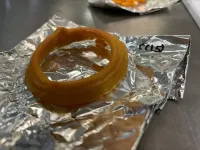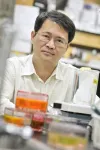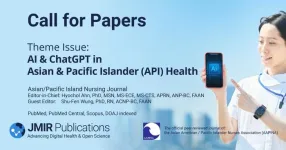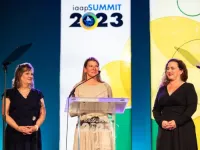(Press-News.org) SAN FRANCISCO, Aug. 13, 2023 — In the refrigerated grocery store aisle, meat alternatives greatly outnumber plant-based seafoods. But more mock seafood options are needed because of unsustainable fishing and aquaculture practices, which can deplete the supply and harm the environment. Today, researchers present a new approach for creating desirable vegan seafood mimics that taste good, while maintaining the healthful profile of real fish. They 3D-printed an ink made from microalgae protein and mung bean protein, and their proof-of-concept calamari rings can even be air-fried for a quick, tasty snack.
The researchers will present their results at the fall meeting of the American Chemical Society (ACS). ACS Fall 2023 is a hybrid meeting being held virtually and in-person Aug. 13-17, and features about 12,000 presentations on a wide range of science topics.
A video on the research is available at www.acs.org/SeafoodMimics.
“I think it's imminent that the seafood supply could be very limited in the future,” adds Poornima Vijayan, a graduate student who is presenting the work at the meeting. “We need to be prepared from an alternative protein point of view, especially here in Singapore, where over 90% of the fish is imported.”
People around the world eat a lot of seafood, but the oceans are not an infinite resource. Overfishing has depleted many wild fish populations. That lack of sustainability, combined with heavy-metal and microplastic contamination, as well as ethical concerns, have pushed some consumers toward plant-based mimics. But such alternatives are still difficult for seafood lovers to find.
While some mock seafood products — such as imitation crabmeat made from minced and reshaped pollock or other white fish — are already on the market, making mimics from plants has been a challenge. It’s hard to achieve the nutritional content, unique textures and mild flavors of cooked fish meat using vegetables or fungi. “Plant-based seafood mimics are out there, but the ingredients don’t usually include protein. We wanted to make protein-based products that are nutritionally equivalent to or better than real seafood and address food sustainability,” says Dejian Huang, Ph.D., the principal investigator of this research.
Recently, Huang and his research group at the National University of Singapore used legume protein to develop better seafood mimics. And they replicated the flakiness and mouth feel of real fish by 3D printing a protein-based ink with a food-grade 3D printer. Depositing the edible ink layer by layer created different textures, some fatty and smooth and others fibrous and chewy, in a single product.
“We printed salmon filets with protein from red lentils because of the protein’s color, and we’ve printed shrimp,” says Huang. “Now, we wanted to print something else interesting with the potential for commercialization — calamari rings.”
In this work, the team tested two sustainable, high-protein plant sources: microalgae and mung beans. Some microalgae already have a “fishy” taste, which Vijayan says made them a good candidate to use in the squid-ring analogue. And mung bean protein is an underutilized waste product from manufacturing starch noodles, also called cellophane or glass noodles, which are a popular ingredient in many Asian dishes.
The researchers extracted microalgae and legume proteins in the lab and combined them with plant-based oils containing omega-3 fatty acids. In the end, the nutritional profile of the high-protein vegan paste was similar to that of calamari rings from squid. Then, the paste was subjected to temperature changes, allowing it to be easily squeezed out of a 3D printer’s nozzles and layered into rings. Finally, the team assessed the finished rings’ taste, smell and appearance.
3D printing gave the seafood mimic structure and texture, but consumers will still want to bake, fry or sauté it, just like they do with real squid, says Huang. So, in an initial cooking test, Vijayan air-fried some of the samples as they would be prepared for a snack. The researchers tried the plant-based calamari, remarking on their acceptable taste and promising texture properties.
Before conducting consumer tests, though, Vijayan wants to optimize the product. “The goal is to get the same texture and elastic properties as the calamari rings that are commercially available,” she says. “I’m still seeing how the composition impacts the product’s elasticity and the final sensory properties.”
And while this plant-based mimic might provide a seafood fix for people with allergies to mollusks, which includes squid, Huang isn’t sure whether people could be sensitive to its ingredients. “I don’t think that there are many known cases of allergies to microalgae proteins or mung bean proteins. But we don’t know yet because it’s still a new combination,” he says.
In the near future, the team plans to develop many prototypes and assess how easily they can be developed for large-scale food manufacturing. Huang expects that in the next few years these calamari-like products could be available in fine-dining restaurants or specialty outlets. “I think people will like our plant-based mimic. From a novelty perspective, it has that seafood taste but comes from only sustainable plant-based sources,” concludes Vijayan.
The researchers acknowledge support and funding from the National University of Singapore. This research is supported by the National Research Foundation, Prime Minister’s Office, Singapore under its Campus for Research Excellence and Technological Enterprise (CREATE) programme. CREATE is an international collaboratory housing research centres set up by top universities. At CREATE, researchers from diverse disciplines and backgrounds work closely together to perform cutting-edge research in strategic areas of interest, for translation into practical applications leading to positive economic and societal outcomes for Singapore. The interdisciplinary research centres at CREATE focus on four areas of interdisciplinary thematic areas of research, namely human systems, energy systems, environmental systems and urban systems. More information on the CREATE programme can be obtained from www.create.edu.sg.
A recorded media briefing on this topic will be posted Monday, Aug. 14, by 10 a.m. Eastern time at www.acs.org/acsfall2023briefings. Reporters can request access to media briefings during the embargo period by contacting newsroom@acs.org.
For health and safety information for ACS Fall 2023, please visit the FAQ webpage.
The American Chemical Society (ACS) is a nonprofit organization chartered by the U.S. Congress. ACS’ mission is to advance the broader chemistry enterprise and its practitioners for the benefit of Earth and all its people. The Society is a global leader in promoting excellence in science education and providing access to chemistry-related information and research through its multiple research solutions, peer-reviewed journals, scientific conferences, eBooks and weekly news periodical Chemical & Engineering News. ACS journals are among the most cited, most trusted and most read within the scientific literature; however, ACS itself does not conduct chemical research. As a leader in scientific information solutions, its CAS division partners with global innovators to accelerate breakthroughs by curating, connecting and analyzing the world’s scientific knowledge. ACS’ main offices are in Washington, D.C., and Columbus, Ohio.
To automatically receive press releases from the American Chemical Society, contact newsroom@acs.org.
Note to journalists: Please report that this research was presented at a meeting of the American Chemical Society.
Follow us: Twitter | Facebook | LinkedIn | Instagram
Title
Effects of microalgae and mung bean protein combination on 3D printing of seafood analogs
Abstract
The employment of 3D printing technology using sustainable alternative protein sources can potentially aid in resolving global food challenges by offering customizable and nutritious food products. Recently, seafood mimics using alternative proteins are gaining traction due to the growing concerns associated with unsustainable practices such as overfishing, heavy metal contamination, and so on. Mung bean protein is an undervalued by-product of the mung bean starch noodle industry, which can be utilized for the development of high-protein seafood mimics. Another such sustainable protein source is microalgae, which is gaining interest due to its high protein content and technologically functional properties. We incorporated them into an ink-based formulation and applied them to a 3D food printer to obtain layer-by-layer deposition to simulate seafood products. The printing performance and characteristics were studied regarding rheology, microstructure, and post-processing stability of 3D-printed seafood analogs. The effects of gellan gum and calcium chloride solution (5 mM) in varying proportions were evaluated to obtain a printable, self-supporting three-dimensional structure. The ink exhibited shear-thinning behavior, and it was observed that adding microalgae protein up to 5% further improved the viscosity, printability, and self-supporting characteristics of the printed structure. The research contributes to the development of plant-based seafood analogs using natural and sustainable alternative protein sources via 3D printing technology.
END
3D-printed vegan seafood could someday be what’s for dinner (video)
2023-08-13
ELSE PRESS RELEASES FROM THIS DATE:
ORNL buildings researchers earn top ASHRAE honors
2023-08-12
Kashif Nawaz and Mahabir Bhandari, building technologies researchers at the Department of Energy’s Oak Ridge National Laboratory, were recognized for research achievements in support of ASHRAE during the 2023 annual conference of the national heating, refrigerating, and air-conditioning engineering society.
Nawaz, a distinguished researcher and head of ORNL’s Buildings Technologies Research Section, received the Crosby Field Award, which honors the highest-rated paper presented before a technical session, a symposium or poster session ...
Raising awareness of Long Covid ‘blue legs’ symptom
2023-08-12
An unusual case of a Long Covid patient’s legs turning blue after 10 minutes of standing highlights the need for greater awareness of this symptom among people with the condition, according to new research published in the Lancet.
The paper, authored by Dr Manoj Sivan at the University of Leeds, focuses on the case of one 33-year man who developed with acrocyanosis – venous pooling of blood in the legs.
A minute after standing, the patient’s legs began to redden and became increasingly blue over time, with veins becoming more prominent. After 10 minutes the colour was much more pronounced, with the patient ...
For labrum tears, regrowth rather than repair
2023-08-12
Tears to the glenoid labrum—cartilage tissue that lines the shoulder where the arm joins—can be repaired with arthroscopic surgery, which significantly weakens the joint and involves a lengthy recovery.
Liping Tang, a bioengineering professor at The University of Texas at Arlington, is developing a new method to repair labrum tears that would enable the body to regenerate tissue to completely reattach the sides of the tear. He recently received a five-year, $2.1 million grant from the National Institutes of Health’s National Institute of Arthritis and Musculoskeletal and Skin Diseases for the research, which would improve the current standard of care ...
Call for papers: Special theme issue: Artificial intelligence (AI) and ChatGPT in Asian and Pacific Islander (API) health
2023-08-11
Asian/Pacific Island Nursing Journal (APINJ) Editor-in-Chief: Hyochol (Brian) Ahn, PhD, MSN, MS-ECE, MS-CTS, APRN, ANP-BC, FAAN and guest editor Shu-Fen Wung, Ph.D., RN, ACNP-BC, FAAN welcome submissions to a special theme issue examining "Artificial Intelligence (AI) and ChatGPT in Asian and Pacific Islander (API) Health."
Generative AI, like ChatGPT, can have many applications in health care and medicine, particularly in addressing the unique needs and challenges faced by API communities. Potential topics related to the use of generative AI in health care and nursing care specific to API health that we ...
SLU ethicists, leading scholars publish guidance for parents, physicians making medical decisions for children
2023-08-11
ST. LOUIS – How should others make decisions for pediatric patients?
For decades, there has been debate in academic literature about the ethical principles that govern medical decision-making for children. In response to this, a group of leading scholars in pediatric ethics participated in a June 2022 symposium, “Best Interests and Beyond: Standards of Decision Making in Pediatrics,” at Saint Louis University. Over the course of three days, the 17 scholars debated one question – in the context of U.S. pediatric care, what moral precepts ought to guide parents and clinicians in medical decision-making for children?
A group of ...
Hundred-year storms? That's how long they last on Saturn.
2023-08-11
The largest storm in the solar system, a 10,000-mile-wide anticyclone called the Great Red Spot, has decorated Jupiter's surface for hundreds of years.
A new study now shows that Saturn — though much blander and less colorful than Jupiter — also has long-lasting megastorms with impacts deep in the atmosphere that persist for centuries.
The study was conducted by astronomers from the University of California, Berkeley, and the University of Michigan, Ann Arbor, who looked at radio emissions from the planet, which come from below the surface, and found long-term disruptions in the distribution ...
New concussion headset shows when it's safe to return to play
2023-08-11
A new digital headset designed to measure alterations in brain function could change decisions about how quickly an athlete is ready to return to play after a concussion. In an evaluation of the device, UC San Francisco researchers found it revealed brain changes even in athletes whose concussion symptoms had gone away, suggesting they could be playing too soon.
Although not yet approved by the Food and Drug Administration (FDA), the device could fill an important niche among athletes, clinicians, trainers and coaches, who are concerned about the long-term effects of repeated sports-related concussions. These include chronic traumatic encephalopathy, ...
CORRECTION: Outdoor air pollution may increase non-lung cancer risk in older adults
2023-08-11
*This press release was amended on August 9, 2023. Due to a mistake in interpretation of data, the previous version of the release stated the study found that NO2 exposure is associated with a decreased risk of breast cancer. The authors have confirmed that the results showed that NO2 exposure is associated with an increased risk of breast cancer.
Key points:
A cohort study of millions of Medicare beneficiaries found that chronic exposures to PM2.5 and NO2 over a 10-year period increased the risk of developing colorectal and prostate cancers.
Even in areas with low pollution levels, researchers found substantial associations between exposures to ...
Zhong named Institute of Food Technologists fellow
2023-08-11
Qixin Zhong, professor in the University of Tennessee Department of Food Science, has been named an Institute of Food Technologists (IFT) Fellow.
The honor was bestowed as a result of Zhong’s years of contribution to food science and to IFT through his scientific, engineering and leadership efforts. In his research enhancing food quality, safety and healthfulness, Zhong creates multilength scale structures to improve the function of food ingredients. His cutting-edge innovations and research developments have impacted countless producers and consumers.
Zhong says he is honored to be named a Fellow, and ...
University of Tennessee extension wins “Employer of the Year” from international organization
2023-08-11
Ask just about any person in the University of Tennessee Extension family what they like about their job, and they might mention the impact they have in their communities and the people they help. Long thought of as a career where you can realize a calling for service, an international organization now confirms what many employees have believed for some time – that UT Extension is a great place to work.
The International Association of Administrative Professionals (IAAP) has named UT Extension as its 2023 Employer of the Year. This ...







